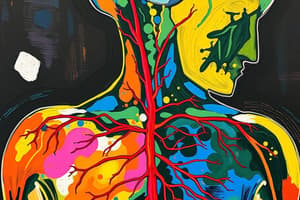Podcast
Questions and Answers
Which part of the nervous system is primarily responsible for processing information and controlling bodily functions?
Which part of the nervous system is primarily responsible for processing information and controlling bodily functions?
The cerebellum is responsible for higher brain functions, including thought and emotion.
The cerebellum is responsible for higher brain functions, including thought and emotion.
False (B)
What are the basic functional units of the nervous system called?
What are the basic functional units of the nervous system called?
Neurons
The _____________ Nervous System prepares the body for stress-related activities.
The _____________ Nervous System prepares the body for stress-related activities.
Signup and view all the answers
Match the following neurotransmitters with their roles:
Match the following neurotransmitters with their roles:
Signup and view all the answers
Which of the following structures provides protection for the spinal cord?
Which of the following structures provides protection for the spinal cord?
Signup and view all the answers
The peripheral nervous system is divided into the somatic and central nervous systems.
The peripheral nervous system is divided into the somatic and central nervous systems.
Signup and view all the answers
Name one type of neuron and its function.
Name one type of neuron and its function.
Signup and view all the answers
Study Notes
Overview of the Nervous System
- The nervous system coordinates the actions of the body by transmitting signals between different parts.
- It is divided into two main parts: the central nervous system (CNS) and the peripheral nervous system (PNS).
Central Nervous System (CNS)
- Consists of the brain and spinal cord.
- Responsible for processing information and controlling bodily functions.
- The brain is divided into several regions:
- Cerebrum: Higher brain functions, including thought, action, and emotion.
- Cerebellum: Coordination and balance.
- Brainstem: Controls basic life functions such as heartbeat and breathing.
Peripheral Nervous System (PNS)
- Comprises all nerves outside the CNS.
- Divided into:
- Somatic Nervous System: Controls voluntary movements and sensory information.
- Autonomic Nervous System (ANS): Regulates involuntary functions (e.g., heart rate, digestion).
- Further divided into:
- Sympathetic Nervous System: Prepares the body for stress-related activities ("fight or flight").
- Parasympathetic Nervous System: Conserves energy and promotes "rest and digest" functions.
- Further divided into:
Neurons
- Basic functional units of the nervous system.
- Types of neurons:
- Sensory Neurons: Transmit sensory information to the CNS.
- Motor Neurons: Send signals from the CNS to muscles and glands.
- Interneurons: Connect neurons within the CNS.
Neurotransmitters
- Chemical messengers used for communication between neurons.
- Common neurotransmitters include:
- Acetylcholine: Involved in muscle activation and memory.
- Dopamine: Plays a role in reward and motivation.
- Serotonin: Affects mood, emotion, and sleep.
Protection of the Nervous System
- The CNS is protected by:
- Skull: Encloses the brain.
- Vertebral column: Encloses the spinal cord.
- Meninges: Three layers of protective tissue (dura mater, arachnoid mater, pia mater).
- Cerebrospinal fluid (CSF): Cushions the brain and spinal cord.
Nervous System Disorders
- Common disorders include:
- Alzheimer’s Disease: Progressive neurodegenerative disorder affecting memory and cognition.
- Parkinson’s Disease: Affects movement, causing tremors and rigidity.
- Multiple Sclerosis (MS): Autoimmune disorder affecting the myelin sheath of neurons.
- Epilepsy: Characterized by recurrent seizures due to abnormal brain activity.
Conclusion
- The nervous system is vital for maintaining homeostasis and enabling interaction with the environment.
- Understanding its structure and functions is crucial for recognizing its importance in health and disease.
Overview of the Nervous System
- Coordinates body actions through signal transmission between various body parts.
- Two main components: central nervous system (CNS) and peripheral nervous system (PNS).
Central Nervous System (CNS)
- Comprises the brain and spinal cord.
- Processes information, controls bodily functions.
- Brain regions:
- Cerebrum: Involved in high-level functions like thought, action, and emotion.
- Cerebellum: Responsible for coordination and balance.
- Brainstem: Manages essential life functions such as heartbeat and breathing.
Peripheral Nervous System (PNS)
- Encompasses all nerves outside the CNS.
- Main divisions:
- Somatic Nervous System: Governs voluntary movements and sensory information.
- Autonomic Nervous System (ANS): Controls involuntary processes, including heart rate and digestion.
- Sympathetic Nervous System: Activates "fight or flight" response during stress.
- Parasympathetic Nervous System: Supports "rest and digest" activities, conserving energy.
Neurons
- Serve as the fundamental units within the nervous system.
- Types:
- Sensory Neurons: Convey sensory data to the CNS.
- Motor Neurons: Relay signals from the CNS to muscles and glands.
- Interneurons: Facilitate communication between neurons within the CNS.
Neurotransmitters
- Act as chemical messengers for neuron communication.
- Notable neurotransmitters:
- Acetylcholine: Key for muscle movement and memory functions.
- Dopamine: Integral to motivation and reward pathways.
- Serotonin: Influences mood, emotional regulation, and sleep patterns.
Protection of the Nervous System
- The CNS is safeguarded by anatomical structures:
- Skull: Protects the brain.
- Vertebral Column: Shields the spinal cord.
- Meninges: Three protective tissue layers (dura mater, arachnoid mater, pia mater).
- Cerebrospinal Fluid (CSF): Provides cushioning for the brain and spinal cord.
Nervous System Disorders
- Notable conditions affecting the nervous system:
- Alzheimer’s Disease: Progressive decline in memory and cognitive abilities.
- Parkinson’s Disease: Disorder impacting movement, associated with tremors and stiffness.
- Multiple Sclerosis (MS): Autoimmune condition disrupting neuron myelin sheaths.
- Epilepsy: Characterized by uncontrolled brain activity leading to seizures.
Conclusion
- Essential for homeostasis and environmental interaction.
- Understanding its structure and function is vital for health and disease comprehension.
Studying That Suits You
Use AI to generate personalized quizzes and flashcards to suit your learning preferences.
Description
This quiz explores the structure and function of the nervous system, detailing its division into the central and peripheral nervous systems. Key components such as the brain, spinal cord, and various subsystems are covered. Test your understanding of how the nervous system coordinates bodily functions.




